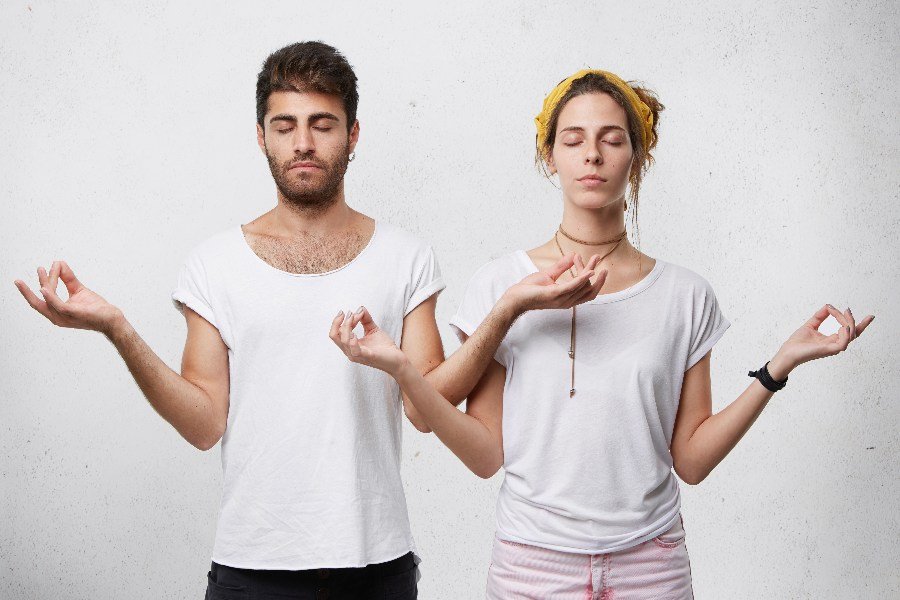What’s the Difference Between Mindfulness and Meditation?

A lot of people treat “mindfulness” and “meditation” as though they are the same, even though they’re not. While they’re closely connected, they have significant differences that can help you understand which practice might work best for you.
Understanding the Basics
What is Meditation?
Meditation is a formal practice where you set aside a specific time to train your mind. It’s similar to giving your brain a workout, just like you would at the gym for your body. You sit in a quiet place, often with your eyes closed, and follow specific techniques to focus your attention.
Key features of Meditation:
- Structured practice sessions
- Usually done in a quiet space
- Specific techniques or methods
- Set time periods (5 minutes to an hour or more)
- Often involves sitting still
What is Mindfulness?
Mindfulness is a way of paying attention to the present moment without judging what’s happening. It’s a mental state you can practice anytime, anywhere. You can be mindful while washing dishes, walking, or even during conversations.
Key features of mindfulness:
- Can be practiced anywhere
- No special posture required
- Focus on present moment awareness
- Non-judgmental observation
- Can be integrated into daily activities
Main Differences Explained
| Aspect | Meditation | Mindfulness |
|---|---|---|
| When | Scheduled practice times | Any moment throughout the day |
| Where | Usually quiet, designated space | Anywhere – kitchen, office, outdoors |
| How Long | Set duration (10-60 minutes) | Continuous or brief moments |
| Position | Often sitting still | Any position – standing, walking, lying |
| Goal | Train the mind, develop skills | Maintain present-moment awareness |
Examples
Meditation example: Sarah sets her alarm 15 minutes early each morning. She sits on a cushion in her bedroom, closes her eyes, and focuses on her breathing until the timer goes off.
Mindfulness example: During his lunch break, Tom notices the taste of his sandwich, the sounds around him, and how his body feels as he eats. He’s not trying to achieve anything specific – just staying aware.
How They Work Together
Meditation and mindfulness support each other like training wheels and riding a bike. Meditation gives you the skills, and mindfulness lets you use those skills in real life.
Training Connection
Regular meditation practice helps you:
- Notice when your mind wanders
- Bring attention back to the present
- Stay calm during stressful situations
- Develop better focus
These skills then make it easier to be mindful during your regular day.
Health Benefits Backed by Science
Meditation Benefits
Research from Harvard Medical School shows that regular Meditation can:
- Reduce stress hormones like cortisol
- Lower blood pressure
- Improve sleep quality
- Strengthen areas of the brain linked to attention
Mindfulness Benefits
Studies published in the Journal of Health Psychology found that mindfulness practice helps:
- Reduce anxiety and depression symptoms
- Improve emotional regulation
- Boost immune system function
- Increase life satisfaction
Combined Benefits Table
| Benefit | Meditation | Mindfulness | Both Together |
|---|---|---|---|
| Stress Reduction | ✓ | ✓ | ✓✓ |
| Better Focus | ✓✓ | ✓ | ✓✓✓ |
| Emotional Balance | ✓ | ✓✓ | ✓✓✓ |
| Daily Calmness | ✓ | ✓✓ | ✓✓✓ |
Getting Started – Practical Tips
For Meditation Beginners
Start small and simple:
- Begin with 5 minutes daily
- Use a meditation app like Headspace or Calm
- Find a quiet corner in your home
- Focus on your breathing
- Don’t worry about “doing it wrong”
Weekly progression plan:
- Week 1-2: 5 minutes daily
- Week 3-4: 10 minutes daily
- Week 5-6: 15 minutes daily
- Month 2+: 20+ minutes daily
For Mindfulness Practice
Easy ways to start:
- Notice three things you can see, hear, and feel right now
- Pay attention to your first bite of each meal
- Take three deep breaths before checking your phone
- Feel your feet touching the ground when walking
- Listen entirely when someone talks to you
Daily mindfulness schedule:
- Morning: Mindful coffee or tea drinking
- Lunch: Mindful eating for first 5 minutes
- Afternoon: Mindful walking between meetings
- Evening: Mindful breathing before bed
Common Mistakes to Avoid
Meditation Mistakes
- Expecting immediate results
- Forcing thoughts to stop (they won’t)
- Comparing your practice to others
- Skipping sessions when feeling stressed (that’s when you need it most)
Mindfulness Mistakes
- Trying to be mindful all day (unrealistic)
- Judging yourself for forgetting to be mindful
- Thinking you need perfect concentration
- Only practicing during good times
Expert Insights
Dr. Jon Kabat-Zinn, founder of Mindfulness-Based Stress Reduction at the University of Massachusetts Medical School, explains: “Meditation is a way of being, not just a technique. Mindfulness means being fully aware by paying deliberate attention to the present moment.”
The World Health Organization recognizes both practices as beneficial for mental health, particularly for managing stress and preventing burnout.
Which Should You Choose?
The good news is you don’t have to pick just one. Most people find success combining both:
Choose Meditation if you:
- Want structured practice
- Prefer quiet, focused time
- Need help with concentration
- Want to build a consistent routine
Choose mindfulness if you:
- Have a busy schedule
- Want immediate stress relief
- Prefer flexible practices
- Want to improve daily experiences
Choose both if you:
- Want maximum benefits
- Have time for formal practice plus daily awareness
- Are you serious about mental wellness
- Want to build both skills and application
References:
- Harvard Health Publishing: “Mindfulness meditation may ease anxiety, mental stress
- Journal of Health Psychology: “Mindfulness interventions and health outcomes”
- World Health Organization: “Mental health and stress management guidelines
- University of Massachusetts Medical School: “Center for Mindfulness Research”
Remember, both mindfulness and Meditation are skills that improve with practice. Start where you feel comfortable, and don’t worry about being perfect. The goal is progress, not perfection.
